Smoked Brisket Flat Recipe
It is hard to beat a perfectly smoked slice of good brisket, and today I want to share with you how to achieve just that with a Smoked Brisket Flat. Beef Brisket is made up of two sections….the leaner, “flat” portion which is what most people think of when you say sliced brisket; and the fattier, pointy end or “Point” section which is where most of the brisket marbling lies. Brisket is sold either as a “whole brisket” (flat & point still connected) or just the flat alone. I’ve never seen just the point section available in my area but it may be in some places. Smoked Brisket Flat by itself can be a bit of a challenge to cook. The flat is lean which makes it is easy to dry out; it’s a hard working muscle which makes it naturally tough; and then after you cook it just right you still have to know how to slice it or you’ll be chewing for hours! But don’t let any of that worry you because I’m going to show you how to cook a perfectly tender piece of brisket flat that will blow your family and friends away. Smoked Brisket Flats in my area normally range from 6-10lbs. I’ve found that Costco and Sam’s typically have them in stock all year long even when whole brisket is hard to find. Look for flats that have a uniform thickness and a good layer of fat on the bottom side.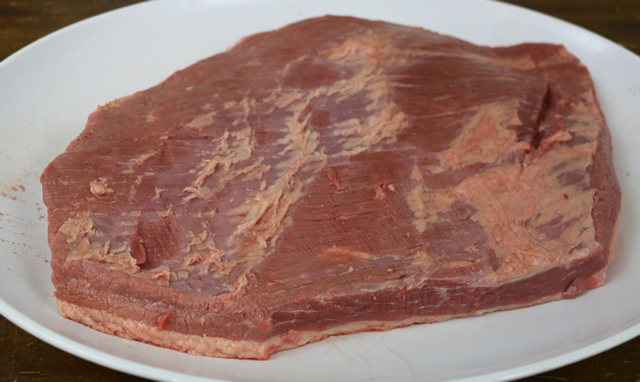 Remove the flat from the packaging and rinse under cool water. Drain any excess water and pat dry with a paper towel. Remove any excess fat from the meat (top) side and any aging from the outer edges. I don’t trim any of the fat from the bottom because it acts as a natural insulator keeping the flat moist.
Remove the flat from the packaging and rinse under cool water. Drain any excess water and pat dry with a paper towel. Remove any excess fat from the meat (top) side and any aging from the outer edges. I don’t trim any of the fat from the bottom because it acts as a natural insulator keeping the flat moist.
 Now it’s ready for a good dose of seasoning on this Smoked Brisket Flat. For brisket I use a 3 step seasoning method. First it gets a good dose of my AP rub on all sides. I keep a batch of this on hand in my kitchen because it’s great on everything. Here’s a quick recipe for making AP.
Next the Smoked Brisket Flat gets a layer of Killer Hog’s The BBQ Rub. Be sure to get the sides as well as the bottom with both the AP & BBQ Rub.
Flip the brisket fat side down and pat the seasonings into the meat. For the last layer of flavor I use a coarse ground Montreal Steak Seasoning to give the bark more texture and a little flavor pop. The Montreal only goes on the meat side of the flat.
At this point you could inject the brisket if you want too, but I prefer a more natural beef taste when cooking brisket at home. Just let the seasoned flat hang out for a few minutes while you fire up the smoker.
Now it’s ready for a good dose of seasoning on this Smoked Brisket Flat. For brisket I use a 3 step seasoning method. First it gets a good dose of my AP rub on all sides. I keep a batch of this on hand in my kitchen because it’s great on everything. Here’s a quick recipe for making AP.
Next the Smoked Brisket Flat gets a layer of Killer Hog’s The BBQ Rub. Be sure to get the sides as well as the bottom with both the AP & BBQ Rub.
Flip the brisket fat side down and pat the seasonings into the meat. For the last layer of flavor I use a coarse ground Montreal Steak Seasoning to give the bark more texture and a little flavor pop. The Montreal only goes on the meat side of the flat.
At this point you could inject the brisket if you want too, but I prefer a more natural beef taste when cooking brisket at home. Just let the seasoned flat hang out for a few minutes while you fire up the smoker.
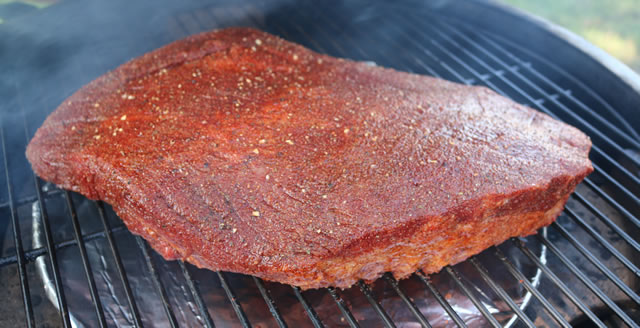 For this cook we’re shooting for a low and slow cook, so I have my Big Green Egg running at 250 degrees with a couple of chunks of pecan and hickory for smoke.
Once the smoker has stabilized, place the Smoked Brisket Flat fat side down on the rack and kick back. The goal here is to keep the lid closed and hold the temperature steady at 250.
For this cook we’re shooting for a low and slow cook, so I have my Big Green Egg running at 250 degrees with a couple of chunks of pecan and hickory for smoke.
Once the smoker has stabilized, place the Smoked Brisket Flat fat side down on the rack and kick back. The goal here is to keep the lid closed and hold the temperature steady at 250.
 For the first part of the smoking process we’re looking to get some color on the outside and raise the internal temperature slowly to 165 degrees. It should take about 4 hours on an 8lb Smoked Brisket Flat like this one. Keep an eye on the color it’s the best indicator at this point. When you see it getting dark, it’s time to wrap.
I use a crisscrossed layer of aluminum foil for this. Center the Smoked Brisket Flat on the foil and bring the edges up and around. Before closing the foil, pour in 1 cup of beef broth for additional moisture. Seal the foil tight and place it back on the smoker.
For the first part of the smoking process we’re looking to get some color on the outside and raise the internal temperature slowly to 165 degrees. It should take about 4 hours on an 8lb Smoked Brisket Flat like this one. Keep an eye on the color it’s the best indicator at this point. When you see it getting dark, it’s time to wrap.
I use a crisscrossed layer of aluminum foil for this. Center the Smoked Brisket Flat on the foil and bring the edges up and around. Before closing the foil, pour in 1 cup of beef broth for additional moisture. Seal the foil tight and place it back on the smoker.
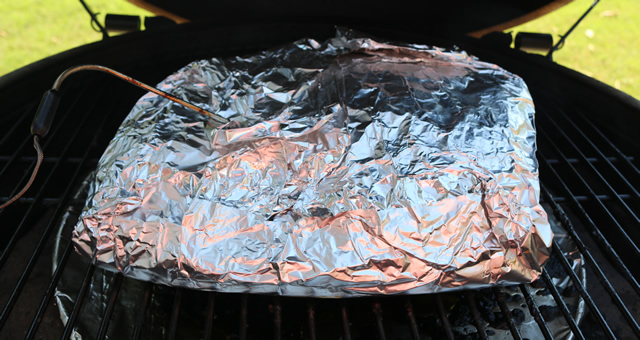 At this point time is out the window. You want to monitor the internal temperature because this is where you can ruin a flat. Smoked Brisket Flat is done when it hits right at 200 degrees and if you over shoot it there’s no coming back.
I highly suggest investing in a good probe thermometer like the thermoworks DOT or Chef Alarm.
At first the temperature will move a little slow but when the flat hits 185 it’s going to gain temperature fast and you need to be there to get it off the pit. It’s also a good idea to test the doneness with a separate thermometer.
Not only are you verifying internal temp but you can feel how the probe goes into the meat. It should have little resistance at this point which is a good indicator that it’s done.
This last piece of advice will step your brisket game up big time and that to let the Smoked Brisket Flat rest for several hours. It’s as simple as wrapping the flat in an old towel and placing in a dry cooler with the lid closed.
Leave it in the dry cooler for a minimum of 2 hours but I’ve went as long as 6 and the brisket it still hot enough to require gloves to slice it. The resting period allows the brisket to calm down and recover some of the moisture lost during cooking.
After a good rest the Smoked Brisket Flat is ready to slice. Unwrap the foil and place the flat on a cutting board.
At this point time is out the window. You want to monitor the internal temperature because this is where you can ruin a flat. Smoked Brisket Flat is done when it hits right at 200 degrees and if you over shoot it there’s no coming back.
I highly suggest investing in a good probe thermometer like the thermoworks DOT or Chef Alarm.
At first the temperature will move a little slow but when the flat hits 185 it’s going to gain temperature fast and you need to be there to get it off the pit. It’s also a good idea to test the doneness with a separate thermometer.
Not only are you verifying internal temp but you can feel how the probe goes into the meat. It should have little resistance at this point which is a good indicator that it’s done.
This last piece of advice will step your brisket game up big time and that to let the Smoked Brisket Flat rest for several hours. It’s as simple as wrapping the flat in an old towel and placing in a dry cooler with the lid closed.
Leave it in the dry cooler for a minimum of 2 hours but I’ve went as long as 6 and the brisket it still hot enough to require gloves to slice it. The resting period allows the brisket to calm down and recover some of the moisture lost during cooking.
After a good rest the Smoked Brisket Flat is ready to slice. Unwrap the foil and place the flat on a cutting board.
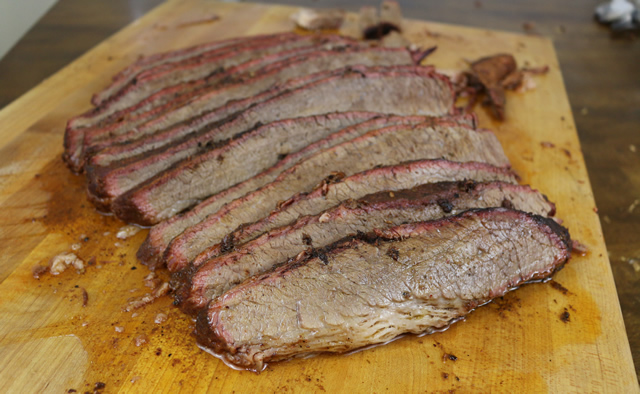 Don’t just toss the foil out though, all that juice that cooked out can be used for Au Jus after separating the fat off the top.
Before you slice the Smoked Brisket Flat locate the direction of the grain. Move out to the edge, and make your first slice Across the Grain. This is crucial, all of your effort will be for nothing if it’s not sliced properly Trust me on this!
Don’t be scared to pick up that first slice and inspect it. Make sure you’re hitting it across the grain. After that the rest is easy; just make repeated slices about ¼” wide down the rest of the Smoked Brisket Flat.
If there’s any excess fat on the bottom of the slices you can remove it, but I usually leave it attached because it’s good eating!
Brisket, especially the flat, can be tricky to perfect but if you season it well, get some smoke on it for a couple hours, wrap and closely monitor the internal temperature, and last but most important rest for a couple hours… you will be well on your way to brisket nirvana.
Malcom Reed
Connect on Facebook
Follow me on Twitter
Subscribe to my YouTube Channel
Find me on Google+
Follow me on Instagram
Don’t just toss the foil out though, all that juice that cooked out can be used for Au Jus after separating the fat off the top.
Before you slice the Smoked Brisket Flat locate the direction of the grain. Move out to the edge, and make your first slice Across the Grain. This is crucial, all of your effort will be for nothing if it’s not sliced properly Trust me on this!
Don’t be scared to pick up that first slice and inspect it. Make sure you’re hitting it across the grain. After that the rest is easy; just make repeated slices about ¼” wide down the rest of the Smoked Brisket Flat.
If there’s any excess fat on the bottom of the slices you can remove it, but I usually leave it attached because it’s good eating!
Brisket, especially the flat, can be tricky to perfect but if you season it well, get some smoke on it for a couple hours, wrap and closely monitor the internal temperature, and last but most important rest for a couple hours… you will be well on your way to brisket nirvana.
Malcom Reed
Connect on Facebook
Follow me on Twitter
Subscribe to my YouTube Channel
Find me on Google+
Follow me on Instagram
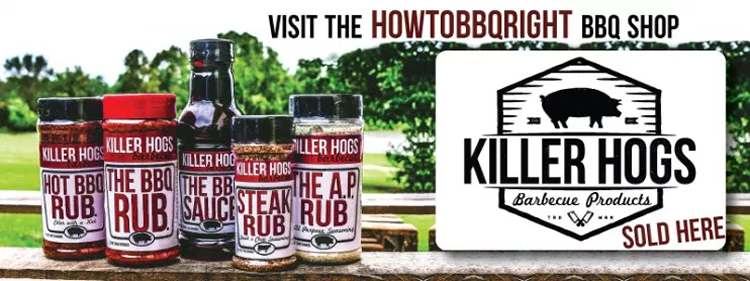 Smoked Brisket Flat
Smoked Brisket FlatHave a Question About This Recipe?
Connect with us in our HowToBBQRight Facebook group for recipe help, to share your pictures, giveaways, and more!

Hey Malcom,
I have a question about wood chunks. I’m finding it very difficult to find Cherry wood to smoke with, so I’m wondering… If I cut a branch off my cherry tree in the back yard, then let it “season”, or dry, for a year or so, would that be the same thing as buying it?
Yeah it would. Letting it season correctly is the key.
What did I do wrong? My eight pound brisket got to 200 degrees after only 6 and a half hours, so I pulled it off and let it rest for about 3 hours. The meat was flavorful, but a bit tough. What should I consider for the next time?
I sounds like it didn’t get done. Make sure you probe it in multiple locations to verify that internal temp. And when you probe it, it should feel like butter – if it feels tight you might need to take it a few extra degrees.
Trying this on my REC TEC next weekend can’t wait to see how it turns out.
Might have missed this. When you wrap it, do you do meat side down or fat side down?
Just made this a couple days ago on my camp chef – I was extremely nervous because I’ve heard brisket is extremely difficult, but it came out amazing! Thank you for these recipes!
I tried doing a Brisket Flat for the first time ever with my BGE, and I have some questions. First – I hit the finish temp of 200-F after 5 hours. Here’s what I did: I started with a 6.5-lb flat, rubbed and refrigerated the night before. I started with a completely cleaned BGE with fresh lump charcoal. I lit the BGE at 7am (figuring it would take all day), let it get going, adjusted bottom and top vents until it was holding steady at 225. I put the flat on fat side down, and after 1.5 hours it had already reached 135 internal temp so I flipped it. After one more hour it had reached 160, so I put it in the Texas crutch with a cup of beef bouillon. After 5 hours it was at 200 internal temp. Now it’s 1:30pm. Still about 4 hours away from our planned dinner time. So I took it off and put it in a cooler to keep warm. When we unwrapped it to eat, there was no smoke ring, but the meat was definitely cooked all the way through. The narrowest tapered end of the flat was actually nice and crusted and kind of pulled apart like pulled pork, while the thicker end of the flat was meaty and solid like a roast beef. I didn’t really have much bark to speak of. The crust was still soft. It seems like my brisket cooked 3 to 4 hours fast than it should have, but I was very attentive to the lid temp, which held steady at 240-250 for the entire 5 hours. Should the whole brisket have been more like the thinner end? It actually seemed a bit more flavorful there. Sorry for so many questions, but this was my first brisket on the BGE (only got it a few months ago), and every website I read prior to doing the brisket said it should take 8 to 10 hours. Mine was half that. Thanks for any advice.
Shawn – I have a Kamado Joe and when I began grilling or smoking with it I noticed that the cooking time was significantly shorter than suggested in any recipes I used. This compelled me to purchase a thermometer with two temp probes. I would insert one into the meat I was smoking and lay the other across the top of the grill grate. I noticed that my lid temp was reading approximately 80 degrees cooler than what the thermometer was reading. Likely, if you thought your BGE was at 250 your actual temp may have been closer to 350. This would explain your shortened cook time.
thanks for the input!
Howdy Malcom, first of all, thank you for all you do. I love the videos. I’m doing a brisket flat this weekend and will do your tricks. Got most of your products. I’ll let you know how it goes. BBQ John
That solves it… I am new to the KJoe and have noticed the same with temp different at the grate than the guage.
You can calibrate your thermometer to read the correct temp water boils at 212 degrees. Put your BGE thermometer in boiling water and if its not reading 212 calibrate it by turning the nut on the back. Easy Peasy!!
I’ve actually calibrated my Kamado Thermometer multiple times, and after being spot on in the boiling water, i’ve seen it run as high as 100 degrees off. I think those thermometers are just poor quality. I always use a 3rd party thermometer when I grill now
Regarding Kamado grill thermometers, it’s likely not the thermometer itself that’s off. It’s the location of it in relation to the heat source. That’s why having a remote digital thermometer directly on the grill grates is best for getting an accurate read of your temp right where your meat is cooking, not 6-12” above it.
When calibrating your thermometer be sure to take in elevation correction. This can be found on line.
https://www.thermoworks.com/bpcalc
Example is at your location boiling point of water may be 207 instead of 212. Say my example was yours. If the gauge is at 207 and water is boiling then things are good. To set your thermometer grasp the probe firmly, grasp the dial and hold probe still. Turn dial left or right to corrected temper of 207 and you are set. When resetting therm back into grill position dial correctly for you liking for reading. Do not adjust reading position by turning dial. Turning the dial for reading likes is how many guages get off caliberation.
I tried doing a Brisket Flat for the first time ever with my BGE, and I have some questions. First – I hit the finish temp of 200-F after 5 hours. Here’s what I did: I started with a 6.5-lb flat, rubbed and refrigerated the night before. I started with a completely cleaned BGE with fresh lump charcoal. I lit the BGE at 7am (figuring it would take all day), let it get going, adjusted bottom and top vents until it was holding steady at 225. I put the flat on fat side down, and after 1.5 hours it had already reached 135 internal temp so I flipped it. After one more hour it had reached 160, so I put it in the Texas crutch with a cup of beef bouillon. After 5 hours it was at 200 internal temp. Now it’s 1:30pm. Still about 4 hours away from our planned dinner time. So I took it off and put it in a cooler to keep warm. When we unwrapped it to eat, there was no smoke ring, but the meat was definitely cooked all the way through. The narrowest tapered end of the flat was actually nice and crusted and kind of pulled apart like pulled pork, while the thicker end of the flat was meaty and solid like a roast beef. I didn’t really have much bark to speak of. The crust was still soft. It seems like my brisket cooked 3 to 4 hours fast than it should have, but I was very attentive to the lid temp, which held steady at 240-250 for the entire 5 hours. Should the whole brisket have been more like the thinner end? It actually seemed a bit more flavorful there. Sorry for so many questions, but this was my first brisket on the BGE (only got it a few months ago), and every website I read prior to doing the brisket said it should take 8 to 10 hours. Mine was half that. Thanks for any advice.
This is going to sound like a simplistic answer but EVERY brisket is unique to itself. That’s why this is more of an art than a science. It will come to temperature when it is ready. Just pay attention to it and add love….you won’t go wrong.
So, I attempted my FIRST ever brisket and even with a mishap of low temp and time, it still came out great! It actually ended up having a pretty awesome smoke ring on and it tasted fantastic! Thanks for the instructions!!
Thanks for the help Malcolm. Your website has become my BBQ bible. Going to try this recipe on my new vertical offset Dynaglo next weekend. Thumbs up!
I’m making a brisket tomorrow and I’d like to use your method but haven’t had a chance to order your rubs yet. Are there any substitutions you can recommend in the short term until I get yours in the mail?
James
You can just use salt & pepper – https://howtobbqright.com/2016/05/23/texas-brisket-recipe/
Tried this on my ceramic kamado with a 5lb Sam’s flat. Smoked fat side down to IT of 165 in the thick of the flat. Smoker stayed at a good consistent 250. I had to re-fire just before the wrap and had a hard time keeping it below 300 the rest of the cook. Wrapped with a cup of beef broth and took it to 205 IT. Let it rest in a cooler 3 hours. Had great flavor and smoke ring but missed in on the moisture. Any suggestion on where to adjust for the next cook?
Could be it was just a dry piece of meat. Brisket will leave you scratching your head (at least it has me several times!). The best advise is to cook it until a probe slides in with almost no effort (usually between 200-210 degrees) then rest it for a couple hours. You can always get a little moisture back by reserving the Au Jus and placing the slices back in it when you serve.
Cooked a 13 lb. prime brisket flat yesterday following your recipe. Everyone loved it and said it was the best and most tender brisket they had ever tasted. Thanks for all of you tips and recipes.
Hello – I followed this recipe for an 8 lb brisket and it was perfect. Due to the salmonella turkey outbreak I’ve decided to smoke brisket and a ham. I’m serving 25 people and plan to smoke a 12 pound brisket. Do I need to change anything with a larger brisket so it doesn’t dry out? I thank you in advance and Happy Thanksgiving!
PS I will also use your ham recipe for the first time. Looking forward to the fabulous flavor.
Just make sure you give the brisket a good rest before slicing
I have a Komodo grille, what is a method that you use to get the long, but not too hot, burn for smoking a brisket?
You should be able to use a Heat Deflector for low and slow cooks on your Komodo Grill
curious about how you set up the wood chunks inside the BGE. Do you layer them throughout? I know that’s a method some people use, but it seems like you’d get a big dose of unpleasant white smoke each time a new chunk caught fire during the cook. Is that an issue I should worry about?
I’ve made a ton of your recipes and have never had any complaints. Thank you for what you do.
I get a hot bed of coals and lay several wood chunks scattered around so they will catch and smoke as the fire burns. If you have a good, seasoned, dry wood it will burn and give you a nice, clean smoke instead of smolder and give you a bad, white smoke.
whats the best way to reheat the flat ,im cooking it saturday and eating sunday , thanks
Thanks for the thorough instructions! I cooked a flat on my Weber Smokey Mountain today. It turned out awesome!
Malcolm, instead of Montreal Steak rub could you use your Killer Hogs Steak rub.
I smoke a flat each time I smoke a brisket. It is just me and I prefer the leaner part. Today I am smoking a 6.79 lb Flat using this recipe and the Texas Style recipe of yours. I put a salt and pepper mixture on the outside first and then Montreal Steak Seasoning. At 3 hours it reached 161 degrees. I wrapped it in butcher paper and now back in until it reaches 200 degrees internal. I use the Therm Pro thermometer and I find it quite accurate. I am also using a Traeger Pro 22. This recipe has been spot on each time I have done it. Thanks Malcom.
I plan to smoke an 8 lb flat on a Camp Chef Woodwind this weekend. I’m trying to understand the differences between the Pellet Grill Brisket recipe and this one. It seems like you’re trying to maximize the smoking time on the pellet grill by setting it to 195. Then trying to preserve the bark with butcher paper. While the Flat recipe you go with 250, foil, and add beef stock. Do you smoke at 250 just to keep the cooking within a day? Would a flat dry out too much if I tried 195 overnight? Would adding stock then wrapping with butcher paper work against each other?
Thanks, Malcom. I’m really looking forward to trying this.
Your method is spot on Malcom. This has been my go too process for several briskets and they all have turned out perfect. Use a good probe thermometer and
“Trust the temperature”. That is key! Thanks Malcom for all of your recipes!
Hey Malcom- how did you get the brisket to go from 165 to 201 in just 2 hours? Especially at 250 degrees?